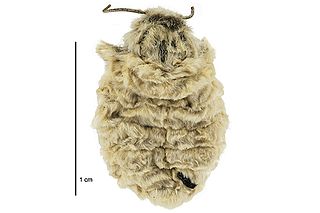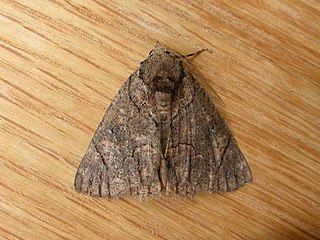
The Platypezoidea are a superfamily of true flies of the section Aschiza. Their closest living relatives are the Syrphoidea, which, for example, contain the hoverflies. Like these, the adults do not burst open their pupal cases with a ptilinum when hatching, thus the Aschiza do not have the inverted-U-shaped suture above the antennae. They are, however, muscomorphs, thus have a particular type of pupal case resembling a rounded barrel and called puparium.

Arthur Mills Lea was an Australian entomologist.

Metacrias is a genus of moths in the family Erebidae. All species are endemic to New Zealand.

Thema protogramma is a species of moth in the family Oecophoridae. It was first described by Edward Meyrick in 1884 and is endemic to Australia. Adults are variable in appearance, but the palpi are distinctive, having a fringe of long hairs underneath that is even in length throughout.

Sciaphila debiliana is a species of moth of the family Tortricidae. It is found in Australia.

Platycepsion wilksoni is an extinct species of prehistoric amphibian, known from partial skeleton deposited in shale at the Gosford Quarry site of the Terrigal Formation in Australia. This specimen may represent a larval stage, as denoted by the presence of external gills, making it the first evidence of larval development in stereospondyls.

Scrobipalpa aptatella is a moth of the family Gelechiidae. It is found in China (Xinjiang), Australia, New Zealand, Samoa, India, Indonesia (Sumatra), Malaysia, Myanmar, Sri Lanka, Palestine and in Africa, where it has been recorded from the Democratic Republic of Congo, Kenya, Malawi, Namibia, South Africa, Tanzania and Zimbabwe.

Heliomystis is a monotypic moth genus in the family Geometridae. Its only species, Heliomystis electrica, the electric moth, is found in the southern half of Australia. Both the genus and species were first described by Edward Meyrick in 1888.
John William Brazier was a malacologist from Australia.
Ironomyiidae is a small family of flies in the order Diptera. Historically, they had been included in the family Platypezidae, and includes three extant species within the single extant genus Ironomyia endemic to Australia and a number of extinct fossil genera from North America and Asia extending back to the Early Cretaceous.
Prays calycias is a species of moth in the family Praydidae. It was described by Edward Meyrick in 1907 and is found in Australia.
Prays inscripta is a species of moth in the family Praydidae. It was described by Edward Meyrick in 1907 and is found in Australia. The larvae feed on Phebalium plants.

Zelleria cynetica is a species of moth in the family Yponomeutidae. It was first described by Edward Meyrick in 1893 and can be found in the Australian states of New South Wales, Queensland, and Tasmania.

Pseliastis is genus of moths in the family Heliozelidae, first described by Edward Meyrick in 1897. Three species are currently described, all endemic to Australia.
Pseliastis spectropa is a species of moth of the family Heliozelidae, described by Edward Meyrick in 1897. It is endemic to Tasmania, Australia.
Pseliastis trizona is a species of moth in the family Heliozelidae, described by Edward Meyrick in 1897. It is endemic to Tasmania, Australia.

Pseliastis xanthodisca is a species of moth in the family Heliozelidae, described by Edward Meyrick in 1897. It is endemic to Tasmania, Australia.
Syntonarcha iriastis is a moth in the family Crambidae. It was described by Edward Meyrick in 1890. It is found in the western Pacific, including Hong Kong, New Caledonia and most of Australia, where it has been recorded from Western Australia, the Northern Territory, Queensland and New South Wales.
Elachista demogenes is a moth in the family Elachistidae. It was described by Edward Meyrick in 1897. It is found in Australia, where it has been recorded from South Australia.
Heosphora is a genus of moths in the family Pyralidae. The genus was first described by Edward Meyrick in 1882. The type species is Anerastia psamathella Meyrick, 1879, designated as such by George Hampson in 1901. All Heosphora species are found in Australia.










